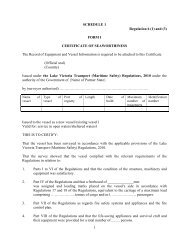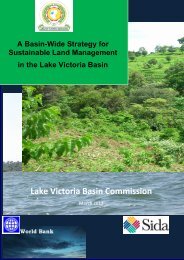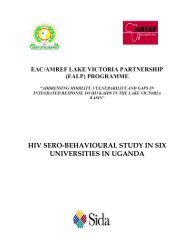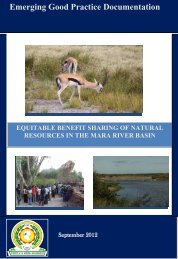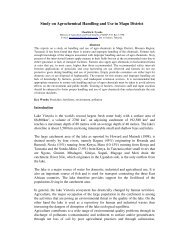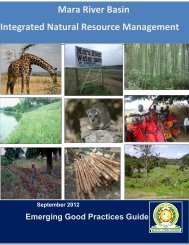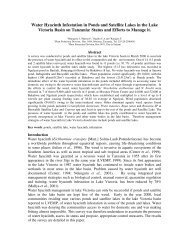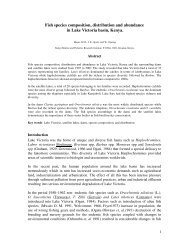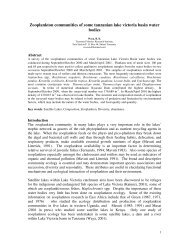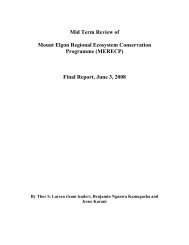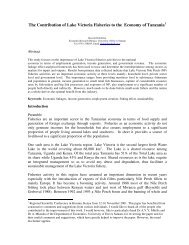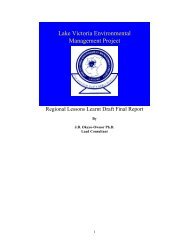1.0 INTRODUCTION1.1 Background to the <strong>Mau</strong> ForestsThe <strong>Mau</strong> complex forms the largest closed canopy forest ecosystem in Kenya coveringapproximately 400,000ha making it one <strong>of</strong> the critical water towers in the country. It issituated at 0°30’ South, 35°20’ East within the Rift Valley Province <strong>and</strong> spans eightadministrative districts: Baringo, Bomet, Bureti, Keiyo, Kericho, Nakuru, N<strong>and</strong>i, <strong>and</strong>Narok. It is a source <strong>of</strong> major rivers <strong>and</strong> streams that make up the hydrological systems<strong>of</strong> Lakes Baringo, Bogoria, Nakuru, Naivasha, Natron <strong>and</strong> Victoria. The originalvegetation pattern <strong>of</strong> the <strong>Mau</strong> complex followed an altitudinal gradient with localtopographical ecoclines. The closed canopy moist pomontane forest at lower altitudesbecomes increasingly intermixed with bamboo from 2,200m above sea level. Purebamboo (Arundinaria alpina) swathes are commonly found between 2,300 <strong>and</strong> 2,500 m.above 2,500m the bamboo gives way to mixed bamboo/tree st<strong>and</strong>s, both associated withgrass clearings that usually represent a sub-climax resulting from burning <strong>and</strong> cutting<strong>of</strong> bamboo. A marginal type <strong>of</strong> montane sclerophyll forest occupies the highest altitudes<strong>of</strong> the <strong>Mau</strong> complex.The <strong>Mau</strong> forest complex is under immense pressure. The threats facing the forests are:extensive clearing <strong>of</strong> natural forest for exotic plantations; conversion <strong>of</strong> natural foreststo agricultural l<strong>and</strong> <strong>and</strong> human settlements; extensive excisions; <strong>and</strong> forest fires. Theunderlying causes <strong>of</strong> deforestation <strong>and</strong> degradation <strong>of</strong> forests have been identified as:• Inadequate recognition <strong>of</strong> the real value <strong>and</strong> the integral role forests play in thelife support system.• Poor implementation <strong>of</strong> existing laws <strong>and</strong> policies particularly in respect toproviding incentives to communities’ to participate in conserving forests.• Major focus on investment in macro-economic policies such as the desire toincrease the growing <strong>of</strong> cash crop for export.• Population growth—the growing population <strong>and</strong> the shrinking productiveagricultural l<strong>and</strong> has forced people to migrate from densely populatedregions/less productive areas to forests.• Emergences <strong>of</strong> the value <strong>of</strong> products products that formerly were unmarketable<strong>and</strong> poverty that have driven poor households into biomass energy sources, e.g.firewood <strong>and</strong> charcoal.12
• Widespread perception on resource scarcity including l<strong>and</strong> that have made forestadjacent communities <strong>and</strong> those for far to encroach on forests <strong>and</strong> extract forestresources to secure their present <strong>and</strong> future livelihoods1.2 <strong>Economic</strong> Importance <strong>of</strong> Selected Forest BlocksThe three forest blocks <strong>of</strong> the <strong>Mau</strong> complex, <strong>Eastern</strong> <strong>Mau</strong> (66,000ha), <strong>Trans</strong>-<strong>Mara</strong>(34,400ha), <strong>and</strong> <strong>Maasai</strong> <strong>Mau</strong> (46,000ha), hereafter referred to as ‘the forest blocks’, formthe catchment <strong>of</strong> many rivers that flow into the Rift Valley <strong>and</strong> Western Kenyaincluding the transboundary <strong>Mara</strong> River. The forest blocks are multi-functional,providing an array <strong>of</strong> goods <strong>and</strong> services. The benefits <strong>of</strong> the forest blocks are reflectedin provision <strong>of</strong> ecological <strong>and</strong> hydrological services <strong>and</strong> support to rural livelihoods,within the proximity <strong>of</strong> the forest blocks <strong>and</strong> downstream. Based on the existingliterature, the market value <strong>of</strong> goods <strong>and</strong> services in support <strong>of</strong> the tourism <strong>and</strong> teasectors from various forest blocks <strong>of</strong> the <strong>Mau</strong> complex is estimated at about KES 20billion per year (MTF, 2008). In addition, an estimated 5 million people directly orindirectly depend on services <strong>and</strong> goods arising from the <strong>Mau</strong> complex. The forestblocks have huge potential to support the national energy needs through hydropowergeneration. The estimated potential <strong>of</strong> hydropower generation associated with theconservation <strong>of</strong> the forest complex is approximately 535MW, or 47% <strong>of</strong> the current totalelectricity generation in Kenya (UNEP, 2008; MTF 2009).The forest blocks also generate a wide range <strong>of</strong> other non-tangible, although equallyimportant, goods <strong>and</strong> services <strong>of</strong> economic value such as ecological functions, touristattractions, biodiversity support, water regulation <strong>and</strong> cultural significance. In addition,the blocks have naturally occurring fauna <strong>and</strong> flora whose economic value is yet to beidentified, signifying some ‘option values’. This implies that the forest blocks couldhave a higher premium than what is actually known. The various stakeholders musttherefore determine the real benefits <strong>and</strong> costs associated with the conservation <strong>of</strong> theforests, especially <strong>and</strong> for future generations. Prospects exist that indeed some <strong>of</strong> theseforest option values may be realized in the immediate future. An example <strong>of</strong> potentialactualization <strong>of</strong> such a vision is the collaborative bio-prospecting arrangement enteredbetween the Tanzania Government <strong>and</strong> the US National Cancer Institute onbiodiversity. The work involves prospecting concession arrangements regarding thesearch for naturally occurring biochemical compounds with commercial values.Environmental stability <strong>and</strong> secured provision <strong>of</strong> ecological goods <strong>and</strong> services in the<strong>Mau</strong> complex in its entirety will remain essential for sustainable development in Kenya<strong>and</strong> for attaining food self-sufficiency <strong>and</strong> poverty alleviation in the Lake Basin region.13



